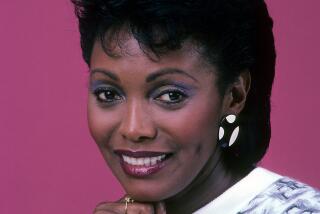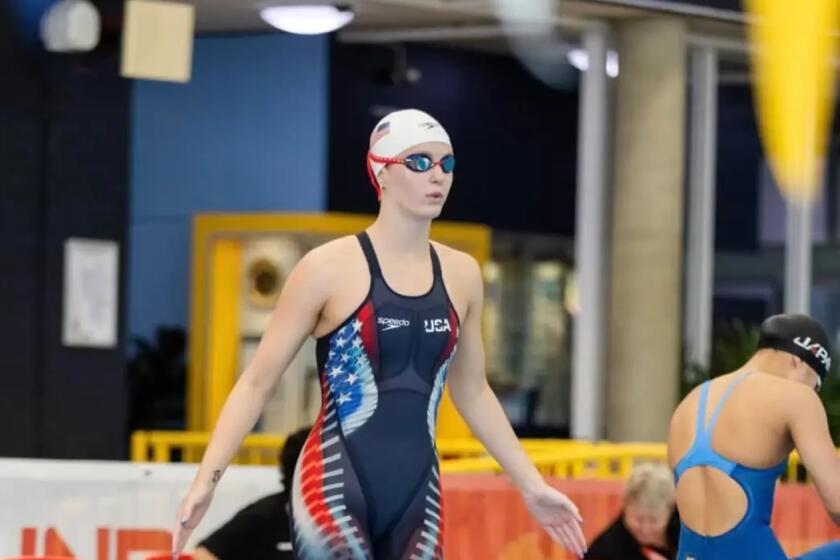Colbert Has Second Shot at Being First
- Share via
Mulligan is a golfer’s term for a second chance. It probably originated with a player by that name who complained that a partner jingled coins or coughed on his backswing or stepped in his line, or that an ambulance went by.
It’s a calumny against the Irish that this wimpy alternative be named after a son of the Auld Sod (why not a McTavish? ), but golf carries its own language.
The pros are not allowed mulligans.
With one exception. Jim Colbert calls it “the great mulligan in life.” It’s the senior tour.
When the eyesight dims, the putts won’t drop anymore, the backswing develops a loop and the putter stutters, the golfer is supposed to have joined the great stockpile of history--yesterday’s heroes.
That’s the way it used to be. Now, they get to play the shot over.
It is the sporting phenomenon of the ‘80s and ‘90s. Where else could a 51-year-old player be “rookie of the year?” Where else could a man who needs bifocals to read a menu read greens well enough to shoot 64?
It used to be in sport, when the hop was gone off your fast one, when your jump shot seemed nailed to the floor, when your serve was clocked at 81 m.p.h. or you couldn’t land the jab or slip a right any more, it was time for the carpet slippers and rocking chair. Or, at least, to get a job selling insurance.
Golf was the same way. When you began to need a four-wood where you used to hit a four-iron, the swing seemed to creak, the nerves made spasms out of three-foot putts, it was time to get a club job.
Oh, there were old-timer baseball games, “masters” track meets or doubles matches and nostalgic basketball matchups, but they were one-shot exhibitions, exercises in sentiment.
But golf’s old-timers game is here to stay.
About a dozen years ago, a New York promoter, Fred Raphael, decided to stage what he called a “Legends of Golf” tournament. It would pit the grand old names against one another for one glorious weekend of remember-when.
It was supposed to be a once-a-year event. But the response was electrifying. The public was enthusiastic, even rabid. So were the media. The golfing masses were delighted to have recognizable names and recognizable silhouettes on the fairways and greens.
Two things were at play:
--There was the comparative anonymity of the modern players.
--There was the discovery that golf is the one game that can be played at almost the same level at 50 as 20. So what if the tee boxes were moved up a tad? So the rough was a little less dense. Maybe the greens weren’t the athletic equivalent of waxed floors.
Hero worship dies hard. Ben Hogan spurned the Legends of Golf, but the rest of the fields included nearly every sports page icon the game had ever known.
A light blinked in the minds of half a dozen overage graduates of the tour. A baseball old-timers’ game can be sad to pathetic. Old-line heroes in other sports can be parodies of themselves. But the senior golf tour was almost indistinguishable from the regular tour--except that you knew everyone on it.
Colbert was one who believed his career was over when the putts stopped dropping on the regular tour in ’87. He made only $15,941 that year, down from $109,517 the year before. He was 194th on the money list.
Jim had sagely begun to pack his earnings into a string of golf courses, aided by his friend, R.D. Hubbard, the race track magnate who now runs Hollywood Park.
Colbert had been one of the second cut of players in his years on the tour, which is to say he wasn’t Nicklaus or Palmer or Hogan. But he won eight tournaments and he played a gutsy, gambling game the public liked. You don’t win eight tournaments laying up.
He won the Colonial and the American Golf Classic. He was fourth in the Masters in ’74. He was third in the ’71 Open--only Jack Nicklaus and Lee Trevino, who were in a playoff for the championship, had a better score. He was fifth in the ’74 Open.
He was a gallery favorite. He had this smiling, happy face, as round and friendly as an apple pie, and he always managed to look on the course as if he were doing something he liked. Colbert was always on or near the leader board. He almost never missed a cut. He didn’t throw clubs when he missed a shot, he giggled.
But he thought the senior tour was for the heavy hitters--Palmer, Nicklaus, Gary Player, Billy Casper, Gene Littler--”the guys who finished first when I was finishing fifth,” he says with a grin.
“It’s a funny thing about this game. Just when you get so you know how to play it, your body runs out on you.”
Not quite. It has to be remembered that Sam Snead won a tour tournament when he was 52 years and 10 months old, Raymond Floyd when he was 49 years and 7 months old.
Then Colbert began to cover the seniors as an ESPN commentator. He decided on the basis of what he saw that he could be competitive, and he hankered to get out there with a wedge instead of a microphone.
Jim Colbert got his clubs out of the attic, cleaned the cobwebs out of his spikes, put on his trademark floppy rain hat--and became a rookie sensation in his 51st year. He won three senior tournaments in 1990, and $880,749.
It took Jim Colbert 22 years on the regular tour to earn $1,553,135. It has taken him a little more than 14 months on the senior tour to win more than $1.2 million.
When he and partner Tommy Aaron came within a putt and an eight-iron or two of overtaking Trevino and Mike Hill in this year’s Legends of Golf, Colbert found himself being almost a bigger celebrity than he ever was after winning, say, the Colonial. When he flew in to appear in the Casa Colina Padua Hills charity classic at Red Hill Country Club, he signed more autographs than he ever had at Augusta or Pebble Beach.
In its 12th year of operation, the senior tour is paying $26 million in prize money. In its 12th year, the regular tour was paying $459,950.
“It’s unbelievable what this senior tour has meant in terms of a second chance,” Colbert says. “Sometimes far greater than the first chance.”
Jim Colbert has taken his mulligan and turned it into an eagle.
More to Read
Go beyond the scoreboard
Get the latest on L.A.'s teams in the daily Sports Report newsletter.
You may occasionally receive promotional content from the Los Angeles Times.










